Gremolata is a vibrant Italian condiment, perfect for elevating your culinary creations. At WHAT.EDU.VN, we understand you’re looking for quick, reliable answers, so let’s dive into what makes gremolata so special. This simple yet flavorful mix of fresh parsley, zesty lemon, and pungent garlic delivers a burst of freshness to any dish. Looking for recipe ideas, usage tips, or creative variations? Let’s explore this amazing topping together to help you understand how to use flavor enhancers in your cooking and discover the beauty of Italian cuisine and how simple recipes can be incredibly impactful.
1. What is Gremolata? A Deep Dive into This Italian Delight
Gremolata, pronounced greh-moh-LAH-tah, is a traditional Italian garnish or condiment originating from Milan. It’s celebrated for its simplicity and ability to brighten and enhance the flavors of various dishes. The classic gremolata recipe consists of only three key ingredients: fresh parsley, lemon zest, and garlic.
1.1 The Core Components of Gremolata
Let’s break down each essential ingredient and explore why they’re crucial to achieving the perfect gremolata:
- Fresh Parsley: Flat-leaf parsley, also known as Italian parsley, is the preferred choice due to its robust flavor and less bitter taste compared to curly parsley. It provides a fresh, herbaceous base for the gremolata.
- Lemon Zest: The zest of a lemon (the outer colored layer of the peel) adds a bright, citrusy note that cuts through richness and balances the other flavors. It’s essential to use only the zest and avoid the white pith, which is bitter.
- Garlic: Fresh garlic, finely minced or grated, contributes a pungent and savory element that complements the parsley and lemon. The amount of garlic can be adjusted to suit your taste preferences.
1.2 A Brief History of Gremolata
While the exact origins are somewhat obscure, gremolata is believed to have originated in Milan, the capital of the Lombardy region of Italy. It’s traditionally served with osso buco, a Milanese specialty of braised veal shanks. The gremolata is sprinkled over the osso buco just before serving, adding a final touch of flavor and freshness.
1.3 Gremolata vs. Other Herb Mixes
Gremolata is sometimes confused with other herb mixes, such as persillade (French) or simply a mixture of chopped herbs. However, the combination of parsley, lemon zest, and garlic is what defines gremolata and distinguishes it from other similar preparations.
Alt text: A vibrant bowl of homemade gremolata, highlighting the fresh parsley, bright lemon zest, and minced garlic, showcasing a classic Italian flavor enhancer.
2. Making Gremolata: A Step-by-Step Guide
Making gremolata at home is incredibly easy and requires minimal effort. Here’s a simple step-by-step guide:
2.1 Gathering Your Ingredients
- 1 bunch fresh flat-leaf parsley, thoroughly washed and dried
- 1-2 lemons, preferably organic, for zesting
- 1-2 cloves fresh garlic
- Pinch of sea salt (optional)
2.2 Preparing the Ingredients
- Parsley: Remove the thick stems and finely chop the parsley leaves. Aim for a consistent, even chop.
- Lemon Zest: Using a microplane or zester, carefully zest the lemons, avoiding the white pith.
- Garlic: Mince the garlic very finely using a knife, or grate it using a microplane.
2.3 Combining the Gremolata
In a small bowl, combine the chopped parsley, lemon zest, and minced garlic. Add a pinch of sea salt, if desired. Mix well to ensure the ingredients are evenly distributed.
2.4 Adjusting to Your Taste
Taste the gremolata and adjust the ingredients to your preference. You may want to add more lemon zest for extra brightness or more garlic for a stronger flavor.
2.5 Tips for the Best Gremolata
- Use Fresh Ingredients: The quality of your ingredients will directly impact the flavor of the gremolata. Use the freshest parsley, lemons, and garlic you can find.
- Chop Finely: Finely chopping or grating the ingredients ensures that the flavors blend together harmoniously.
- Don’t Over-Process: Avoid using a food processor, as it can easily over-process the parsley and create a mushy texture.
- Make it Fresh: Gremolata is best made fresh, just before serving. This will ensure the most vibrant flavor and aroma.
Alt text: The essential gremolata ingredients: fresh flat-leaf parsley, vibrant lemons for zesting, and pungent garlic cloves, laying the foundation for a flavorful Italian garnish.
3. Ways to Use Gremolata: Unleash Its Flavor Potential
Gremolata is incredibly versatile and can be used to enhance a wide range of dishes. Here are just a few ideas to get you started:
3.1 Classic Applications
- Osso Buco: The traditional pairing! Sprinkle gremolata over braised veal shanks just before serving.
- Roasted Meats: Gremolata adds a bright, fresh finish to roasted lamb, chicken, or pork.
- Grilled Fish: Enhance the flavor of grilled fish, such as salmon, tuna, or swordfish, with a sprinkle of gremolata.
3.2 Vegetable Dishes
- Roasted Vegetables: Toss roasted vegetables, such as asparagus, Brussels sprouts, or carrots, with gremolata for a burst of flavor.
- Grilled Vegetables: Elevate grilled vegetables like zucchini, eggplant, or bell peppers with a sprinkle of gremolata.
- Salads: Add gremolata to salads for a fresh, herbaceous element.
3.3 Pasta and Grain Dishes
- Pasta: Toss cooked pasta with olive oil, Parmesan cheese, and gremolata for a simple yet flavorful dish.
- Risotto: Stir gremolata into risotto just before serving for a bright, aromatic finish.
- Grains: Add gremolata to cooked grains like quinoa, couscous, or farro for a flavorful side dish.
3.4 Other Creative Uses
- Soups: Garnish soups with a dollop of gremolata for added flavor and texture.
- Dips: Stir gremolata into dips like hummus or baba ghanoush for a fresh, herbaceous twist.
- Sandwiches: Add gremolata to sandwiches or wraps for a burst of flavor.
- Pizza: Sprinkle gremolata over pizza after baking for a fresh, aromatic topping.
Alt text: A chef carefully selecting fresh Italian parsley, the foundation of an authentic gremolata, emphasizing the importance of quality ingredients.
4. Gremolata Variations: Customizing Your Flavor Profile
While the classic gremolata recipe is delicious on its own, there are many ways to customize it to suit your taste preferences or complement specific dishes. Here are a few ideas:
4.1 Herb Swaps
- Cilantro: Substitute cilantro for parsley for a Southwestern-inspired gremolata. This pairs well with tacos, grilled fish, or avocado.
- Basil: Use basil instead of parsley for a more summery, Mediterranean flavor. This is delicious with pasta, tomatoes, and mozzarella.
- Mint: Add mint for a refreshing twist. This is excellent with lamb, peas, or yogurt.
4.2 Citrus Variations
- Orange Zest: Replace lemon zest with orange zest for a sweeter, more floral flavor.
- Lime Zest: Use lime zest for a tangy, zesty flavor that pairs well with Mexican or Asian dishes.
- Grapefruit Zest: Add grapefruit zest for a slightly bitter, complex flavor.
4.3 Adding Extra Ingredients
- Pine Nuts: Add toasted pine nuts for a nutty, crunchy texture.
- Parmesan Cheese: Stir in finely grated Parmesan cheese for a salty, savory element.
- Red Pepper Flakes: Add a pinch of red pepper flakes for a touch of heat.
- Capers: Finely minced capers add a salty, briny flavor.
- Anchovies: For an umami boost, add finely minced anchovies.
- Olives: Chopped olives bring a salty, savory flavor.
- Shallots: Add finely minced shallots for a mild onion flavor.
4.4 Experimenting with Spices
- Fennel Seeds: Add a pinch of crushed fennel seeds for a subtle anise flavor.
- Cumin: A touch of cumin can add warmth and earthiness, especially good with cilantro gremolata.
- Smoked Paprika: Adds a smoky depth to the gremolata.
Alt text: A chef expertly chopping fresh parsley for gremolata, highlighting the importance of a fine mince for optimal flavor and texture in this classic Italian condiment.
5. Frequently Asked Questions About Gremolata
Let’s address some common questions about gremolata:
| Question | Answer |
|---|---|
| Can I make gremolata ahead of time? | Gremolata is best made fresh, but you can prepare the ingredients (chop parsley, zest lemon, mince garlic) separately and combine them just before serving. |
| How long does gremolata last? | Freshly made gremolata is best consumed within a few hours. If stored in an airtight container in the refrigerator, it may last for up to a day, but the flavors will diminish. |
| Can I freeze gremolata? | Freezing is not recommended, as it will affect the texture and flavor of the parsley and garlic. |
| What if I don’t have a microplane for zesting? | You can use a vegetable peeler to remove strips of lemon zest and then finely chop the strips with a knife. |
| Can I use dried parsley? | Fresh parsley is essential for gremolata. Dried parsley will not provide the same flavor or texture. |
| What if I’m allergic to garlic? | You can omit the garlic or substitute it with a small amount of finely minced shallot or a pinch of garlic powder. |
| What’s the best way to store lemons for zesting? | Store lemons in the refrigerator. Before zesting, wash and dry the lemon thoroughly. You can also roll the lemon on the counter to help release the oils in the zest. |
| Can I use other types of citrus fruit? | Yes, you can experiment with different citrus fruits like oranges, limes, or grapefruits to create different flavor profiles. |
| Is gremolata gluten-free and vegan? | Yes, gremolata is naturally gluten-free and vegan. |
| Where can I find more information about Italian cuisine? | Websites like Food & Wine, Bon Appetit, and The Silver Spoon offer a wealth of information and recipes related to Italian cooking. Cookbooks by Italian chefs like Marcella Hazan and Lidia Bastianich are also excellent resources. You can also ask WHAT.EDU.VN |
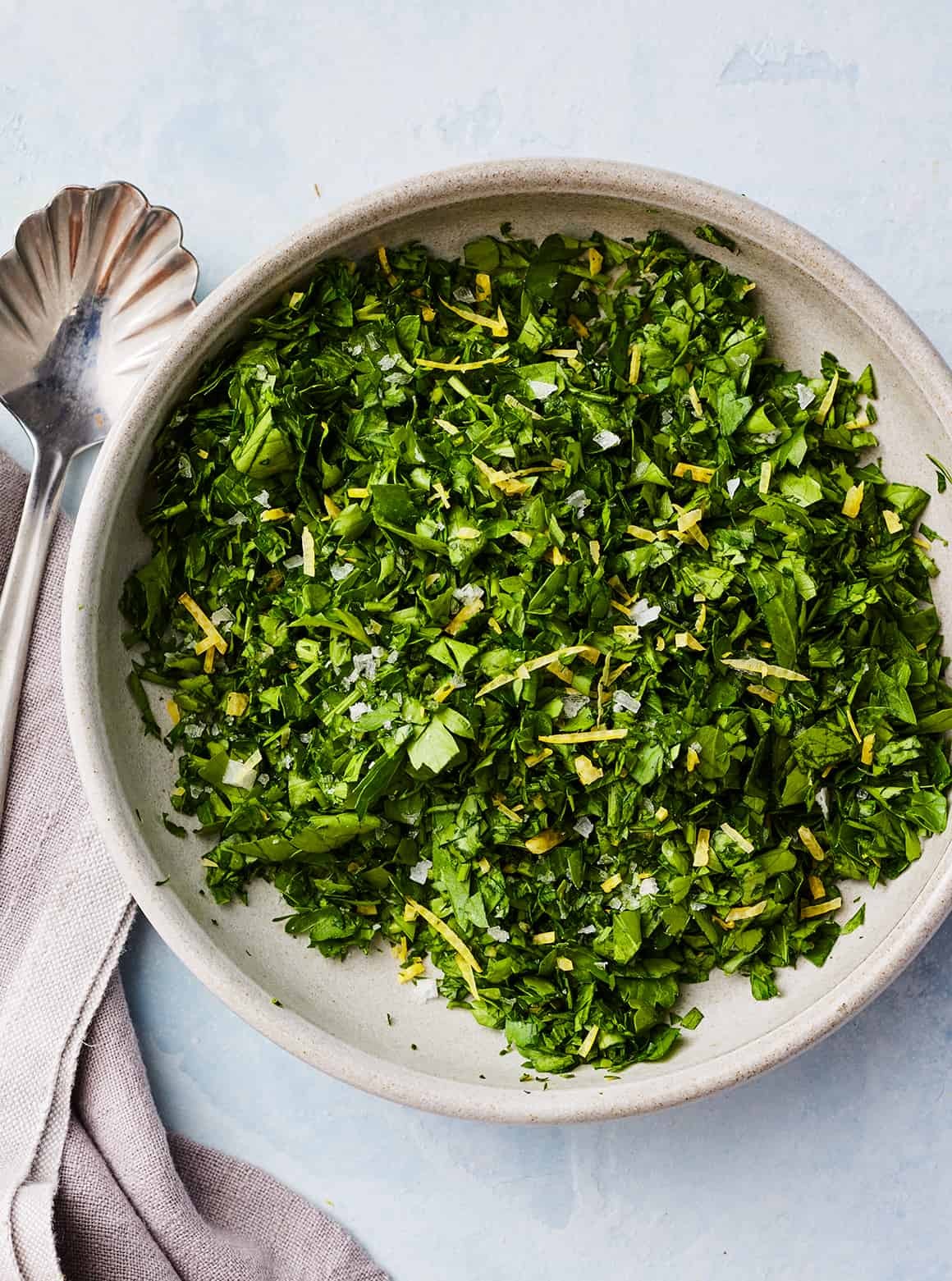

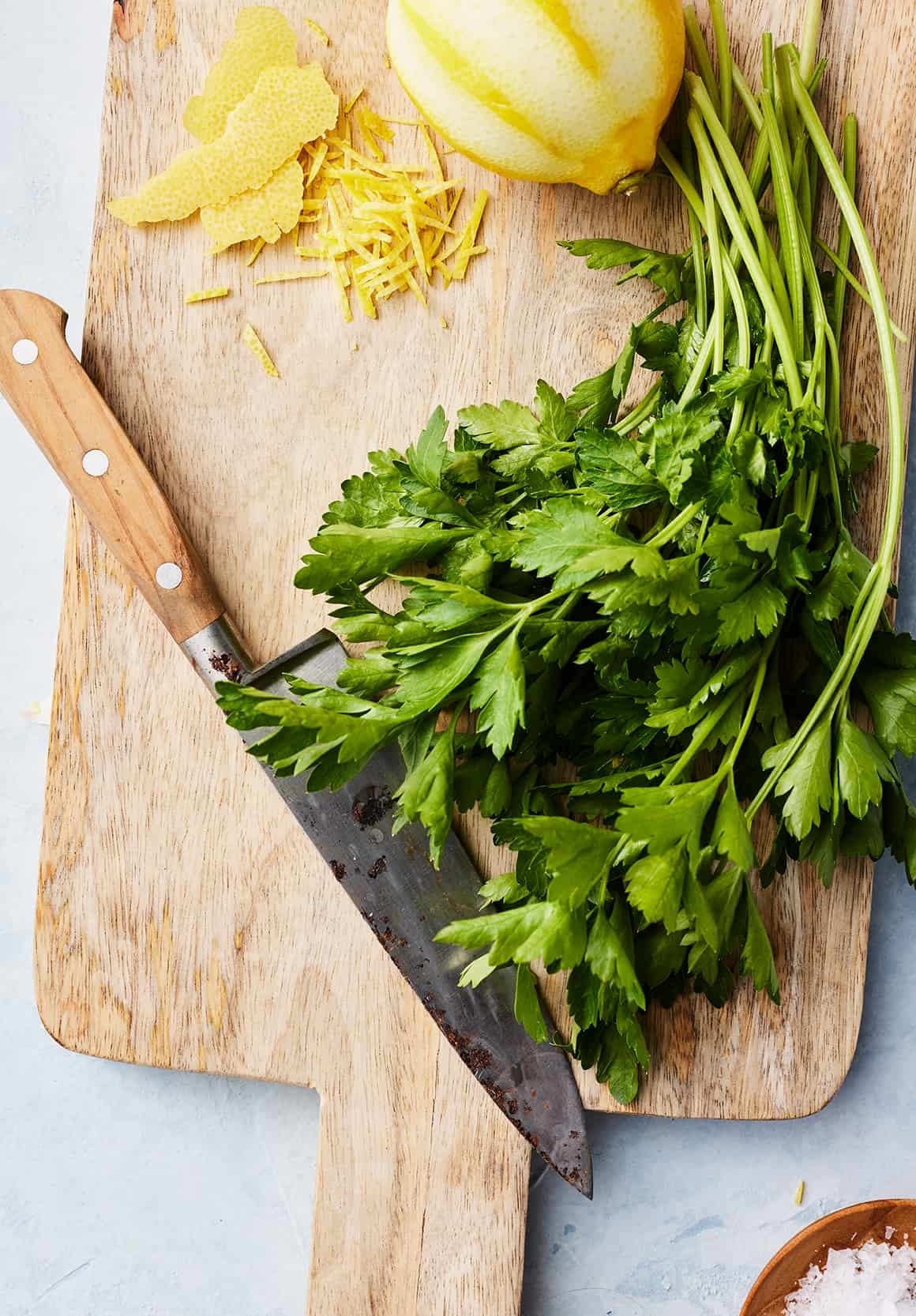
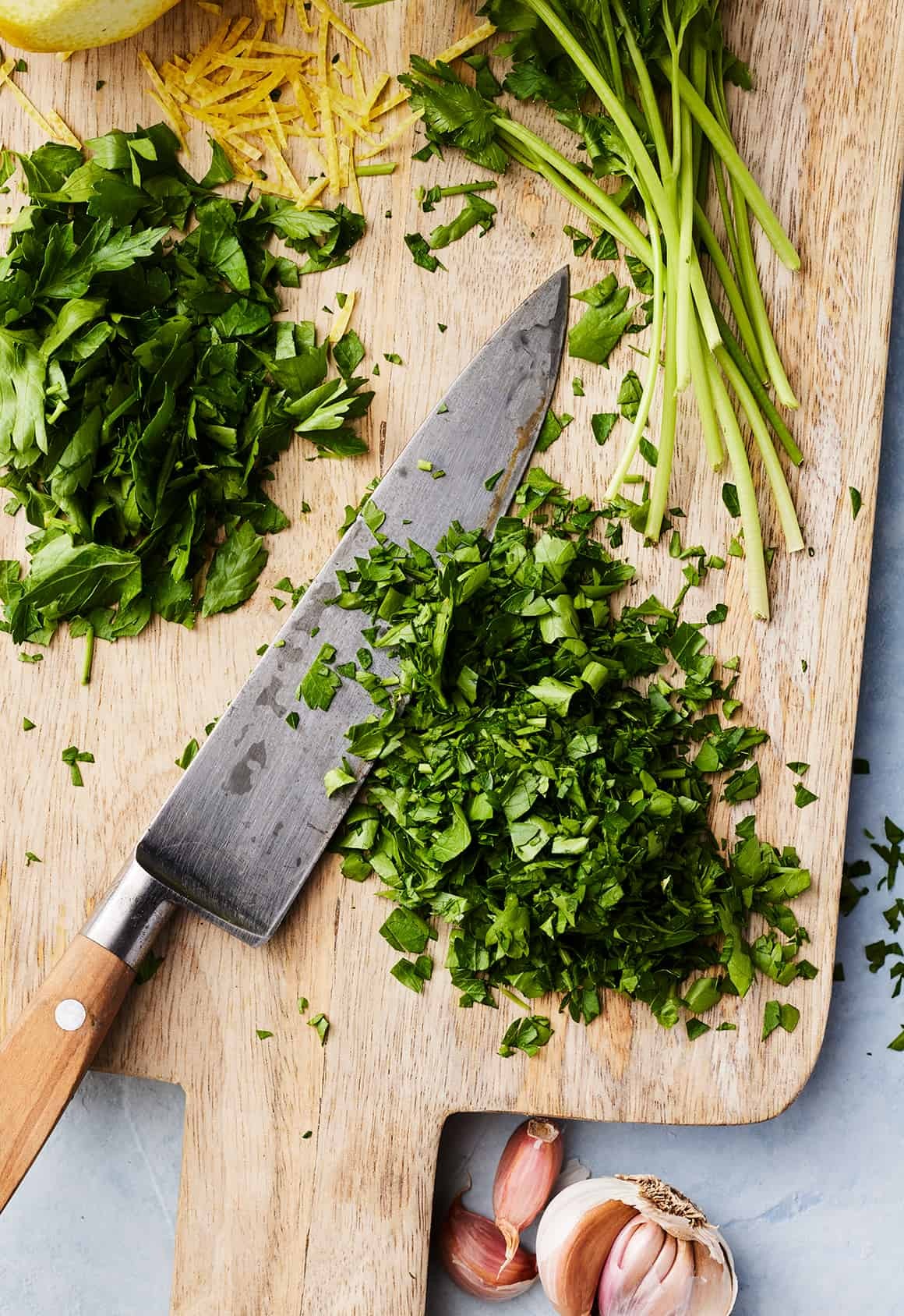
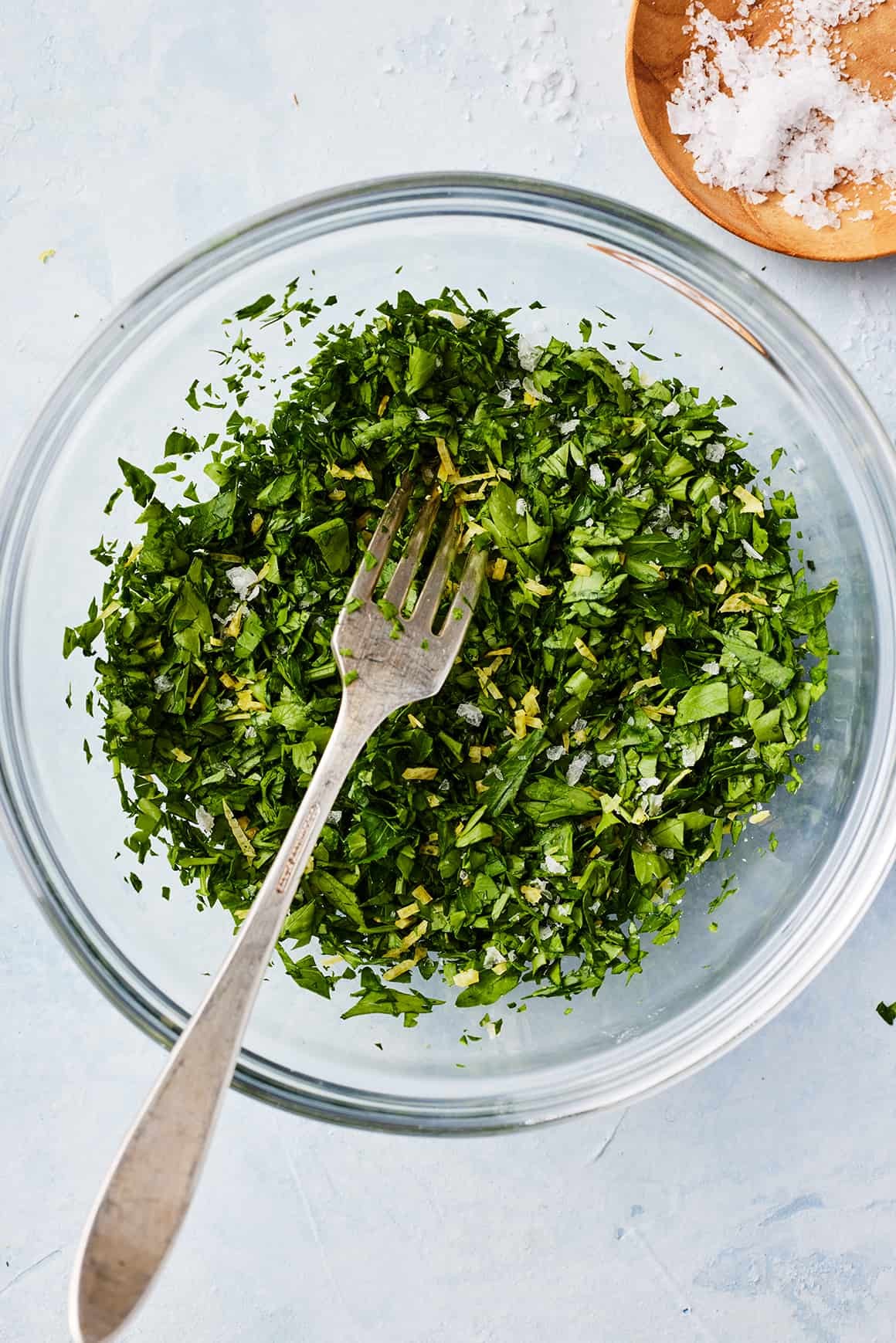
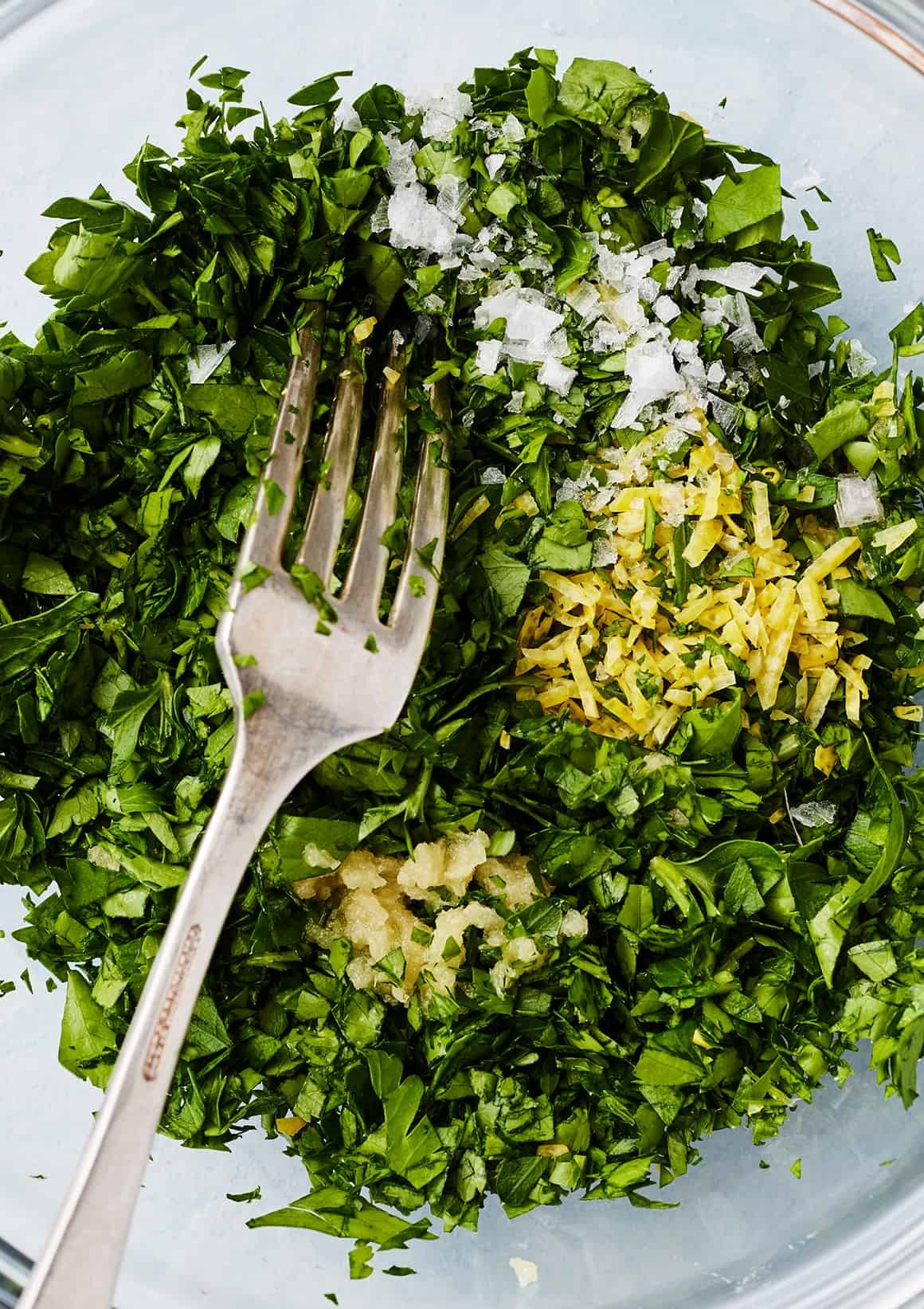
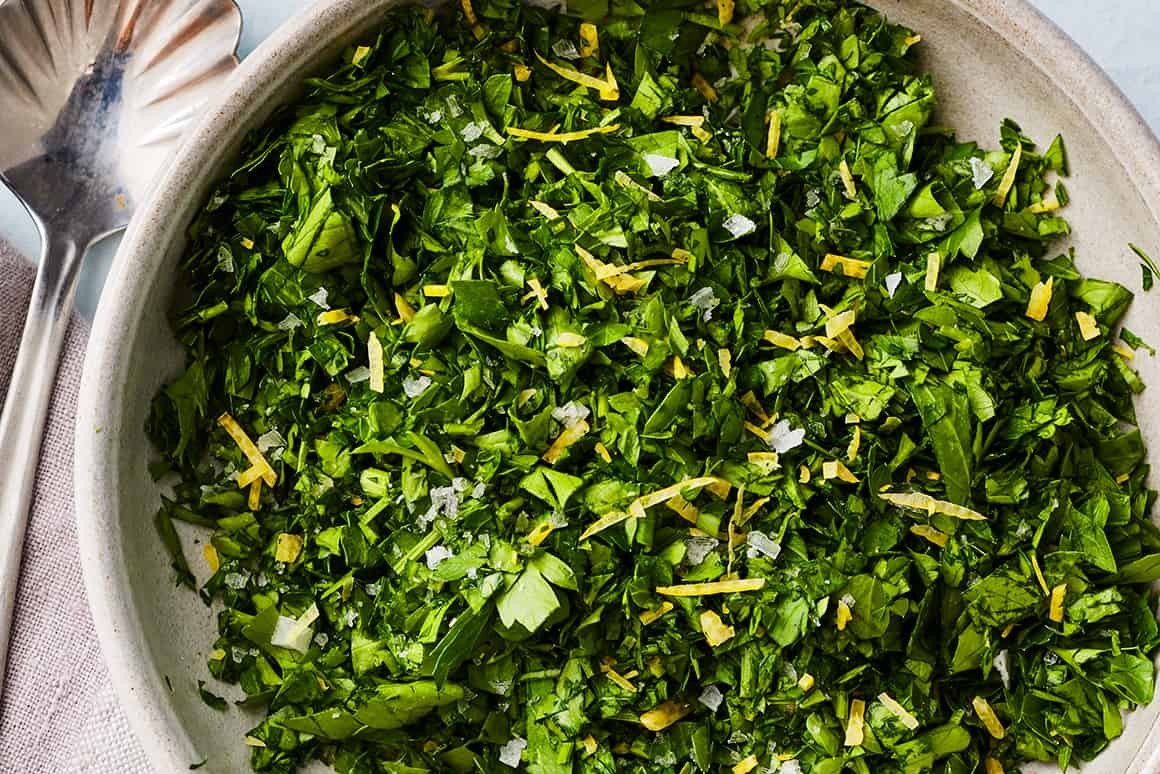
6. The Nutritional Benefits of Gremolata Ingredients
Besides its flavor-enhancing qualities, gremolata also offers some nutritional benefits thanks to its key ingredients:
6.1 Parsley
Parsley is rich in vitamins A, C, and K, as well as antioxidants. It’s also a good source of folate and iron.
6.2 Lemon Zest
Lemon zest contains vitamin C and antioxidants. It also provides limonene, a compound that may have anti-inflammatory and anti-cancer properties, according to research published in the “Journal of Agricultural and Food Chemistry”.
6.3 Garlic
Garlic is known for its immune-boosting and anti-inflammatory properties. It contains allicin, a compound that has been shown to have antibacterial and antiviral effects, according to the National Center for Complementary and Integrative Health.
Alt text: A delicate glass bowl filled with vibrant lemon gremolata, ready to add a zesty and herbaceous touch to a variety of culinary dishes.
7. Gremolata Around the World: Regional Variations
While gremolata is traditionally Italian, similar herb-based condiments exist in other cuisines around the world:
7.1 Persillade (France)
Persillade is a French condiment made from parsley and garlic. It is often used to season dishes at the end of cooking or as a garnish.
7.2 Chimichurri (Argentina)
Chimichurri is an Argentinian sauce made from parsley, garlic, oregano, red wine vinegar, and olive oil. It is commonly served with grilled meats.
7.3 Zhoug (Yemen)
Zhoug is a Yemeni hot sauce made from cilantro, parsley, garlic, chili peppers, and spices. It is often used as a condiment or marinade.
7.4 Salsa Verde (Mexico)
Salsa verde is a Mexican green sauce made from tomatillos, cilantro, onion, garlic, and chili peppers. It is commonly served with tacos, enchiladas, and other Mexican dishes.
8. Gremolata: A Culinary Staple
Gremolata is a simple yet powerful condiment that can transform a dish from ordinary to extraordinary. Its bright, fresh flavors and versatility make it a valuable addition to any cook’s repertoire.
8.1 Embrace Simplicity
One of the beauties of gremolata is its simplicity. With just three core ingredients, it’s easy to make and customize to your liking.
8.2 Experiment with Flavors
Don’t be afraid to experiment with different herbs, citrus fruits, and other ingredients to create your own unique gremolata variations.
8.3 Elevate Your Cooking
Use gremolata to add a burst of flavor and freshness to a wide range of dishes, from roasted meats and vegetables to pasta and soups.
8.4 Share the Flavor
Introduce your friends and family to the magic of gremolata and inspire them to elevate their own cooking.
Alt text: A bowl containing the simple yet vibrant ingredients of gremolata – chopped parsley, lemon zest, garlic, and salt – ready to be mixed into a flavorful sauce.
9. Gremolata and the Art of Simple Cooking
Gremolata embodies the principles of simple cooking: using fresh, high-quality ingredients to create flavorful and satisfying dishes. It’s a testament to how a few well-chosen ingredients can make a big impact.
9.1 The Importance of Freshness
The success of gremolata hinges on the freshness of its ingredients. Fresh parsley, lemons, and garlic will deliver the most vibrant flavor and aroma.
9.2 The Power of Balance
Gremolata’s success lies in the balance of its flavors: the fresh, herbaceousness of parsley, the bright, citrusy notes of lemon zest, and the pungent, savory element of garlic.
9.3 Elevating Everyday Meals
Gremolata can elevate even the simplest of meals, turning a basic pasta dish or roasted vegetable into a culinary experience.
10. Beyond the Recipe: The Joy of Culinary Exploration
Gremolata is more than just a recipe; it’s an invitation to explore the world of flavor and experiment with different ingredients. It encourages you to think creatively about how to enhance your cooking and to appreciate the simple pleasures of fresh, homemade food.
10.1 Find Your Inspiration
Explore cookbooks, websites, and food blogs to find inspiration for new gremolata variations and ways to use it in your cooking.
10.2 Trust Your Taste Buds
Don’t be afraid to experiment with different ingredients and flavor combinations to find what you like best.
10.3 Embrace the Process
Cooking should be a joyful and creative process. Relax, have fun, and enjoy the journey of culinary exploration.
Alt text: A simple and flavorful gremolata recipe, showcasing the fresh ingredients and easy preparation, perfect for adding a bright touch to any dish.
11. Discover More Culinary Delights with WHAT.EDU.VN
At WHAT.EDU.VN, we’re passionate about providing you with quick, reliable answers to all your culinary questions. From basic cooking techniques to exploring international cuisines, we’re here to help you on your culinary journey. Do you want to learn more about food preparation techniques and expand your knowledge in the food and beverages? Visit WHAT.EDU.VN today!
11.1 Your Questions Answered
Do you have a burning question about a specific ingredient, cooking method, or recipe? Our team of experts is here to provide you with clear, concise answers.
11.2 A World of Culinary Knowledge
Explore our vast library of articles, recipes, and tips covering a wide range of culinary topics.
11.3 Join Our Community
Connect with other food lovers and share your own culinary experiences and discoveries.
12. Ready to Elevate Your Cooking? Ask WHAT.EDU.VN!
Are you eager to try making gremolata but unsure where to start? Do you have questions about ingredient substitutions or variations? Don’t hesitate to ask!
12.1 Get Instant Answers
Our platform is designed to provide you with immediate, helpful answers to all your culinary inquiries.
12.2 Free Expert Advice
Benefit from the knowledge and experience of our culinary experts, completely free of charge.
12.3 Join the Conversation
Engage with our community of food enthusiasts and share your own tips, tricks, and recipes.
12.4 Contact Us Today
Visit WHAT.EDU.VN at 888 Question City Plaza, Seattle, WA 98101, United States, or contact us via WhatsApp at +1 (206) 555-7890. We’re here to help you unlock your culinary potential.
13. Embrace the Flavor of Gremolata Today!
Gremolata is a simple yet extraordinary condiment that can transform your cooking. With its bright, fresh flavors and endless versatility, it’s a must-have in every kitchen. So, gather your ingredients, get creative, and start exploring the delicious world of gremolata today. And remember, if you have any questions along the way, WHAT.EDU.VN is here to help! Embrace the convenience and ease of asking your questions and receiving expert answers on our platform. Visit what.edu.vn and experience the joy of culinary discovery today!
